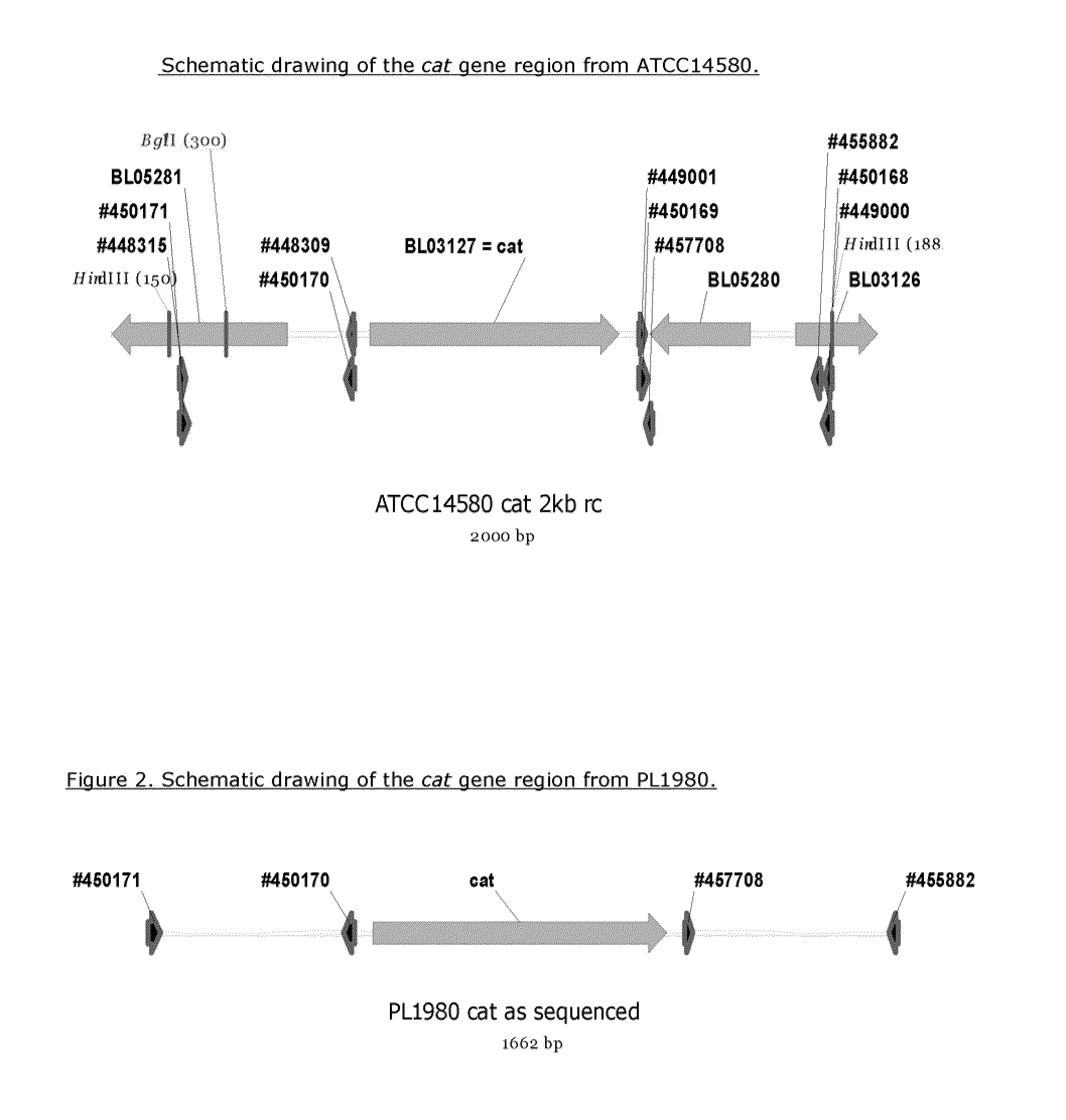Chloramphenicol resistance selection in Bacillus licheniformis
a technology of licheniformis and chloramphenicol, which is applied in the field of modified licheniformis host cells, can solve the problems of hammering the use of chloramphenicol for selection purposes
- Summary
- Abstract
- Description
- Claims
- Application Information
AI Technical Summary
Problems solved by technology
Method used
Image
Examples
example 1
Cat Deletion in Bacillus licheniformis PL1980
Construction of Deletion Plasmid
[0078]Primers were designed, based on the ATCC14580 genome sequence, to allow PCR amplification of a 0.5 kb segment 5′ of the cat gene, and another 0.5 kb segment 3′ of the cat gene. The DNA sequence of the cat-gene region of B. licheniformis ATCC14580 is shown in SEQ ID NO: 1, and the encoded protein is shown in SEQ ID NO: 2.
[0079]PCR amplifications were performed using DNA from B. licheniformis PL1980 as template, and READY-TO-GO™ PCR beads from Amersham Pharmacia Biotech, Inc., as described by the supplier, in the following program on a PTC-200 PCR machine from MJ Research:
[0080]
1 cycle95° C. 2 minutes30 cycles94° C. 30 secondsannealingX° C. 1 minute (different temperatures were used in this step)72° C. 2 minutes, followed by 1 cycle of 72° C. for 5 minutes, whereafter reactions were cooled to 10° C.
The following primers were used:
[0081]
SEQ ID NO: 3 (#449000):5′ cagtgaattcgtttaaccggcaattcttcSEQ ID NO: 4...
example 2
Cat Gene Deletion in the ATCC14580 Strain
[0101]A few attempts were made to introduce the cat-deletion into the ATCC14580 chromosome like it was done in the above, via integration and excision of a deletion plasmid introduced via conjugation from SJ8039-SJ8042. We obtained transconjugants and subsequently strains with integrated plasmids, but could not isolate the desired excision derivatives carrying the cat deletion. As this might be due to the sequence differences between the two different B. lichenformis strains in the cat gene region, a new deletion vector was constructed.
Construction of Deletion Plasmid
[0102]A boiled cell suspension of ATCC14580 was used as template in PCR reactions with primer combination #450168+#450169 (to give a fragment 3′ of cat), and with primer combination #450170+#450171 (to give a fragment 5′ of cat), using 57° C. as annealing temperature.
[0103]The 3′ fragment was digested with EcoRI+SalI and ligated to EcoRI+SalI digested pUC19 vector, and the ligati...
example 3
Test of Chloramphenicol Resistance
[0109]Strains PP1897-3, SJ8071 (=PP1897-3 delta cat), ATCC14580, and SJ8344 (=ATCC14580 delta cat) were propagated in 10 ml TY (WO 94 / 14968, p16) supplemented with 0.5% glucose at 30° C. overnight, with shaking. 50 microliter aliquots were used to inoculate further 10 ml TY+glucose cultures, supplemented with chloramphenicol (cam) to concentrations: 1 microgram / ml, 2 microgram / ml, 3 microgram / ml, 6 microgram / ml, 9 microgram / ml, or 12 microtram / ml, and incubation with shaking continued at 30° C. Growth was scored by visual inspection of turbidity after approximately 7 hours (table 1), and again after overnight incubation (table 2).
[0110]
TABLE 11 μg / ml2 μg / ml3 μg / ml6 μg / ml9 μg / ml12 μg / mlStraincamcamcamcamcamcamPP1897-3+++++−−−SJ8071+−−−−−ATCC14580++++−−−SJ8344+−−−−−After 7 hours incubation: ++) good growth, +) weak growth, −) no growth.
[0111]
TABLE 21 μg / ml2 μg / ml3 μg / ml6 μg / ml9 μg / ml12 μg / mlStraincamcamcamcamcamcamPP1897-3+++++++++++SJ8071+++++++++ATC...
PUM
| Property | Measurement | Unit |
|---|---|---|
| inhibitory concentration | aaaaa | aaaaa |
| inhibitory concentration | aaaaa | aaaaa |
| inhibitory concentration | aaaaa | aaaaa |
Abstract
Description
Claims
Application Information
 Login to View More
Login to View More - R&D
- Intellectual Property
- Life Sciences
- Materials
- Tech Scout
- Unparalleled Data Quality
- Higher Quality Content
- 60% Fewer Hallucinations
Browse by: Latest US Patents, China's latest patents, Technical Efficacy Thesaurus, Application Domain, Technology Topic, Popular Technical Reports.
© 2025 PatSnap. All rights reserved.Legal|Privacy policy|Modern Slavery Act Transparency Statement|Sitemap|About US| Contact US: help@patsnap.com

